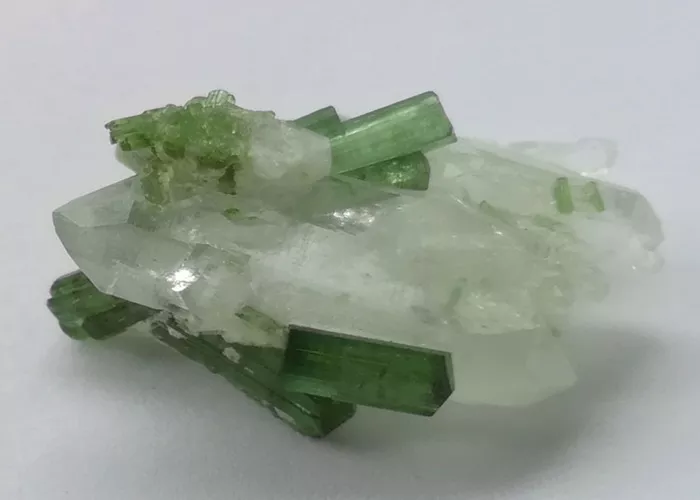Tourmaline is a fascinating gemstone renowned for its diverse colors, including a striking green variety. This article aims to explore the intricate factors that contribute to the green coloration of tourmaline, delving into its chemical composition, formation processes, and the unique physical properties that result in its vibrant hues. By understanding these elements, we can appreciate the complexity and beauty of this gemstone from a scientific perspective.
Chemical Composition and Formation
Tourmaline belongs to a group of boron-containing minerals often found in granite and other igneous rocks. Its chemical composition is complex, with all tourmalines containing boron, silicon, oxygen, and hydrogen. Varieties of tourmaline also contain differing amounts of aluminum, calcium, fluorine, iron, magnesium, lithium, and sodium. This variability in composition plays a crucial role in determining the color and physical properties of the gemstone.
The formation of tourmaline crystals is equally intriguing. They often form long, thin crystals with three, six, or nine sides. These crystals can develop within pegmatites, coarse-grained rocks that form from boron-rich liquids left over when magma cools and begins to harden. Brazil is the world’s leading producer of tourmaline, thanks to its geological conditions conducive to the formation of these minerals.
The Green Hue: A Combination of Factors
The green coloration of tourmaline is a result of several factors, including its chemical composition and the conditions under which it forms. One of the primary contributors to green tourmaline is the presence of iron and chromium in its structure. The exact amount and ratio of these elements, along with other trace elements, determine the shade and intensity of the green color.
Iron and Chromium Content
Iron is a common impurity in many minerals, and in tourmaline, it often plays a role in coloration. Chromium, on the other hand, is less common but can have a significant impact on the color of gemstones. When iron and chromium are present in tourmaline in certain proportions, they interact with the crystal structure to produce a green hue.
Crystal Structure and Light Interaction
The crystal structure of tourmaline also plays a vital role in its coloration. Tourmaline crystals have a complex internal structure, including channels along which ions can be arranged. The specific arrangement of ions within these channels can affect how light interacts with the gemstone. When light enters a tourmaline crystal, it can be absorbed, reflected, or transmitted in various ways, depending on the crystal’s composition and structure. The green color we see is a result of specific wavelengths of light being absorbed while others are reflected or transmitted.
Formation Conditions
The conditions under which tourmaline forms also influence its color. For instance, the temperature and pressure during crystallization can affect the incorporation of impurities into the crystal structure. Higher temperatures and pressures may favor the incorporation of certain elements, leading to different coloration. Additionally, the chemical environment in which the crystal forms can also play a role. For example, the presence of certain fluids or gases during crystallization can alter the composition of the gemstone and, consequently, its color.
Types of Green Tourmaline
Within the broad category of green tourmaline, there are several distinct types, each with its own unique characteristics and coloration.
Elbaite
Elbaite is a lithium-rich variety of tourmaline that can exhibit a wide range of colors, including pink, blue, green, and yellow. Green elbaite is particularly sought-after for its vibrant hue and transparency. The color intensity and shade can vary depending on the amount and type of impurities present in the crystal.
Verdelite
Verdelite is a specific type of green tourmaline that is characterized by its deep, vivid green color. This coloration is often due to a higher concentration of iron and chromium in the crystal structure. Verdelite is highly valued in the gemstone industry for its striking appearance and rarity.
Chrome Tourmaline
Chrome tourmaline is another type of green tourmaline that gets its name from the high chromium content in its structure. This results in a very intense and vivid green color, often with a slight blue or yellow hue. Chrome tourmaline is relatively rare and highly valued for its unique coloration and hardness.
Practical Applications and Identification
Understanding the factors that contribute to the green hue of tourmaline is not just an academic exercise. It has practical implications for the gemstone industry, particularly in the areas of identification, valuation, and treatment.
Identification
Identifying the type and quality of tourmaline can be challenging, as there are many varieties with similar appearances. However, gemologists rely on a combination of visual inspection, spectroscopic analysis, and other testing methods to determine the composition and origin of tourmaline. The presence of specific impurities and the crystal structure can provide clues about the gemstone’s identity.
Valuation
The value of tourmaline is influenced by several factors, including color, clarity, cut, and carat weight. Green tourmaline, especially those with vivid and intense hues, tends to be more valuable than lighter or more muted shades. Gemologists assess these factors to determine the market value of the gemstone.
Treatment
Some tourmaline gemstones undergo treatments to enhance their color or clarity. For instance, heating can sometimes darken the color of lighter tourmaline or remove unwanted inclusions. However, it is important to note that treatments can affect the gemstone’s value and should be disclosed to buyers. Gemologists use advanced testing methods to detect any treatments that have been applied to a tourmaline gemstone.
Conclusion
The green hue of tourmaline is a result of a complex interplay of factors, including its chemical composition, crystal structure, and formation conditions. Understanding these elements not only allows us to appreciate the beauty of this gemstone from a scientific perspective but also has practical implications for the gemstone industry. From identification and valuation to treatment and care, a deep understanding of tourmaline’s coloration can guide professionals in the gemstone industry to make informed decisions and ensure that consumers receive accurate information about the gemstones they purchase.
Related topic:
- What Is Pink Tourmaline
- How to Identify Pink Tourmaline
- Where Is Pink Tourmaline Most Commonly Found


